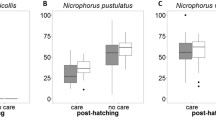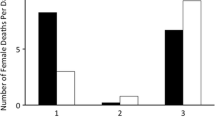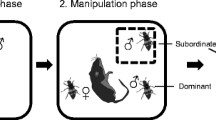Abstract
Parents evaluate multiple extrinsic and intrinsic cues when making decisions associated with reproduction. These decisions often reflect classic trade-offs between the cost of a strategy and its perceived fitness payoff. Life history theory predicts that when parents experience austere conditions, reproductive success is increased by producing fewer but larger offspring with a competitive advantage in this environment. Conversely, parents experiencing favorable conditions are expected to increase current reproductive success by favoring quantity over quality of offspring. We tested the predictions of life history theory using Nicrophorus marginatus (Coleoptera: Silphidae), a burying beetle species that exhibits infanticide during biparental care and hypervariable adult size across populations, by employing a factorial design that manipulated density and nutritional quality of food. We measured (1) the average number of offspring produced, (2) the average individual size of offspring, and (3) the sex ratio of the offspring. We found no effect of density or food quality on offspring sex ratio, but mean offspring size and number differed between low and high-density treatments. Nutritional environment interacted with density effects such that parents with access to high quality diets were able to modulate offspring size and number to match the perceived competitive environment, whereas those in poor nutritional condition appeared to exhibit physiological constraints to producing optimal brood structures.







Similar content being viewed by others
References
Aho T, Kuitunen M, Suhonen J, Jäntti A (2010) Determination of clutch size in treecreepers Certhia familiaris under food and time constraints. Ornis Fennica 87:77
Angelier F, Clément-Chastel C, Gabrielsen GW, Chastel O (2007) Corticosterone and time–activity budget: an experiment with black-legged kittiwakes. Horm Behav 52:482–491
Bartlett J (1987) Filial cannibalism in burying beetles. Behav Ecol Sociobiol 21:179–183
Bartlett J, Ashworth CM (1988) Brood size and fitness in Nicrophorus vespilloides (Coleoptera: Silphidae). Behav Ecol Sociobiol 22:429–434
Blanckenhorn WU, Fanti J, Reim C (2007) Size-dependent energy reserves, energy utilization and longevity in the yellow dung fly. Physiol Entomol 32:372–381
Boggs CL (1997) Dynamics of reproductive allocation from juvenile and adult feeding: radiotracer studies. Ecology 78:192–202
Bolnick DI, Svanback R, Araujo MS, Persson L (2007) Comparative support for the niche variation hypothesis that more generalized populations also are more heterogeneous. Proc Natl Acad Sci Biol 104:10075–10079
Brockelman WY (1975) Competition, the fitness of offspring, and optimal clutch size. Am Nat 109:677–699
Brown DR, Sherry TW (2006) Food supply controls the body condition of a migrant bird wintering in the tropics. Oecologia 149:22–32
Brown WD, Smith AT, Moskalik B, Gabriel J (2006) Aggressive contests in house crickets: size, motivation and the information content of aggressive songs. Anim Behav 72:225–233
Buser CC, Ward PI, Bussière LF (2014) Adaptive maternal plasticity in response to perceptions of larval competition. Funct Ecol 28:669–681
Chamorro-Florescano IA, Favila ME, Macias-Ordonez R (2011) Ownership, size and reproductive status affect the outcome of food ball contests in a dung roller beetle: when do enemies share? Evol Ecol 25:277–289
Charnov EL (1982) The theory of sex allocation. Princeton University Press, Princeton
Clutton-Brock TH (1991) The evolution of parental care. Princeton University Press, Princeton
Cooper NW, Sherry TW, Marra PP (2015) Experimental reduction of winter food decreases body condition and delays migration in a long-distance migratory bird. Ecology 65:1933–1942
Creighton JC (2005) Population density, body size, and phenotypic plasticity of brood size in a burying beetle. Behav Ecol 16:1031–1036. doi:10.1093/beheco/ari084
Cruickshank T, Wade MJ (2012) Maternal adjustment of the sex ratio in broods of the broad-horned flour beetle, Gnathocerus cornutus. Integr Comp Biol 52:100–107
Descamps S, Bêty J, Love OP, Gilchrist HG (2011) Individual optimization of reproduction in a long-lived migratory bird: a test of the condition-dependent model of laying date and clutch size. Funct Ecol 25:671–681
Eggert AK, Müller JK (1997) Biparental care and social evolution in burying beetles: lessons from the larder. In: Choe JC, Crespi BJ (eds) The evolution of social behavior in insects and arachnids. Cambridge University Press, Cambridge, pp 216–236
Fox CW (1997) The ecology of body size in a seed beetle, Stator limbatus: persistence of environmental variation across generations? Evolution 51:1005–1010
Fox CW, Czesak ME (2000) Evolutionary ecology of progeny size in arthropods. Annu Rev Entomol 45:341–369
Goubault M, Mack AF, Hardy IC (2007) Encountering competitors reduces clutch size and increases offspring size in a parasitoid with female-female fighting. Proc R Soc Lond B 274:2571–2577
Hamel S, Festa-Bianchet M, Côté SD (2016) Offspring sex in mountain goat varies with adult sex ratio but only for mothers in good condition. Behav Ecol Sociobiol 70:123–132
Hanks L, Millar J, Paine T (1996) Body size influences mating success of the eucalyptus longhorned borer (Coleoptera: Cerambycidae). J Insect Behav 9:369–382
Hassell M (1975) Density-dependence in single-species populations. J Anim Ecol 44:283–295
Honěk A (1993) Intraspecific variation in body size and fecundity in insects: a general relationship. Oikos 66:483–492
Hopwood PE, Moore AJ, Tregenza T, Royle NJ (2016) Niche variation and the maintenance of variation in body size in a burying beetle. Ecol Entomol 41:96–104
Hsu BY, Dijkstra C, Darras VM, Vries B, Groothuis TG (2016) Maternal adjustment or constraint: differential effects of food availability on maternal deposition of macro-nutrients, steroids and thyroid hormones in rock pigeon eggs. Ecol Evol 6:397–411
Inzani EL, Marshall HH, Sanderson JL, Nichols HJ, Thompson FJ, Kalema-Zikusoka G, Hodge SJ, Cant MA, Vitikainen EIK (2016) Female reproductive competition explains variation in prenatal investment in wild banded mongooses. Sci Rep 6:20013
Kingma SA, Hall ML, Peters A (2011) No evidence for offspring sex-ratio adjustment to social or environmental conditions in cooperatively breeding purple-crowned fairy-wrens. Behav Ecol Sociobiol 65:1203–1213
Kitaysky AS, Wingfield JC, Piatt JF (1999) Dynamics of food availability, body condition and physiological stress response in breeding black-legged kittiwakes. Funct Ecol 13:577–584
Kitaysky AS, Piatt JF, Hatch SA, Kitaiskaia EV, Benowitz-Fredericks ZM, Shultz MT, Wingfield JC (2010) Food availability and population processes: severity of nutritional stress during reproduction predicts survival of long-lived seabirds. Funct Ecol 24:625–637
Komdeur J, Daan S, Tinbergen J, Mateman C (1997) Extreme adaptive modification in sex ratio of the Seychelles warbler’s eggs. Nature 385:522–525
Lack D (1947) The significance of clutch-size. Ibis 89:302–352
Leips J, Richardson JML, Rodd FH, Travis J (2009) Adaptive maternal adjustments of offspring size in response to conspecific density in two populations of the least killifish, Heterandria formosa. Evolution 63:1341–1347
Milne LJ, Milne M (1976) The social behavior of burying beetles. Sci Am 235:84–89
Nager RG, Ruegger C, Van Noordwijk AJ (1997) Nutrient or energy limitation on egg formation: a feeding experiment in great tits. J Anim Ecol 66:495–507
Nager RG, Monaghan P, Griffiths R, Houston DC, Dawson R (1999) Experimental demonstration that offspring sex ratio varies with maternal condition. Proc Natl Acad Sci Biol 96:570–573
Otronen M (1988) The effect of body size on the outcome of fights in burying beetles (Nicrophorus). Finn Zool Bot Publ Board 25:191–201
Pellerin S, Paquette SR, Pelletier F, Garant D, Bélisle M (2016) The tradeoff between clutch size and egg mass in tree swallows Tachycineta bicolor is modulated by female body mass. J Avian Biol 47:500–507
Rauter CM, Moore AJ (2002) Evolutionary importance of parental care performance, food resources, and direct and indirect genetic effects in a burying beetle. J Evol Biol 15:407–417. doi:10.1046/j.1420-9101.2002.00412.x
Rauter CM, Rust RL (2012) Effect of population density on timing of oviposition and brood size reduction in the burying beetle Nicrophorus pustulatus Herschel (Coleoptera: Silphidae). Psyche. doi:10.1155/2012/437518
Rauter CM, Mcguire MJ, Gwartney MM, Space JE (2010) Effect of population density and female body size on number and size of offspring in a species with size-dependent contests over resources. Ethology 116:120–128. doi:10.1111/j.1439-0310.2009.01720.x
Robertson IC (1993) Nest intrusions, infanticide, and parental care in the burying beetle, Nicrophorus orbicollis (Coleoptera: Silphidae). J Zool 231:583–593. doi:10.1111/j.1469-7998.1993.tb01940.x
Roff DA (1992) The evolution of life histories: theory and analysis. Chapman & Hall, New York
Roff DA (2002) Life history evolution. Sinauer Associates Inc., Sunderland. doi: 10.1016/b978-0-12-384719-5.00087-3
Royle NJ, Smiseth PT, Kölliker M (2012) The evolution of parental care. Oxford University Press, Oxford
Schrader M, Jarrett BJM, Kilner RM (2015) Parental care masks a density-dependent shift from cooperation to competition among burying beetle larvae. Evolution 69:1077–1084. doi:10.1111/evo.12615
Schrader M, Jarrett BJM, Kilner RM (2017) Using experimental evolution to study adaptations for life within the family. Am Nat 185:610–619
Scott MP (1990) Brood guarding and the evolution of male parental care in burying beetles. Behav Ecol Sociobiol 26:31–39
Scott MP (1997) Reproductive dominance and differential ovicide in the communally breeding burying beetle Nicrophorus tomentosus. Behav Ecol Sociobiol 40:313–320
Scott MP, Traniello JFA (1990) Behavioral and ecological correlates of male and female parental care and reproductive success in burying beetles (Nicrophorus spp.). Anim Behav 39:274–283
Shine R (1988) The evolution of large body size in females: a critique of Darwin’s” fecundity advantage” model. Am Nat 131:124–131
Smiseth PT, Lennox L, Moore AJ (2007) Interation between parental care and sibling compeititon: parents enhance offspring growht and exacerbate sibling competition. Evolution 61:2331–2339. doi:10.1111/j.1558-5646.2007.00192.x
Smith CC, Fretwell SD (1974) The optimal balance between size and number of offspring. Am Nat 108:499–506
Smith G, Trumbo ST, Sikes DS, Scott MP, Smith RL (2007) Host shift by the burying beetle, Nicrophorus pustulatus, a parasitoid of snake eggs. J Evol Biol 20:2389–2399
Smith AN, Creighton JC, Belk MC (2015) Differences in patterns of reproductive allocation between the sexes in Nicrophorus orbicollis. PLoS ONE 10(11):e0143762. doi:10.1371/journal.pone.0143762
Solomon ME (1949) The natural control of animal populations. J Anim Ecol 18:1–35
Stearns SC (1992) The evolution of life histories. Oxford University Press, Oxford
Stearns SC (2000) Life history evolution: successes, limitations, and prospects. Naturwissenschaften 87:476–486
Steiger S, Richter K, Müller JK, Eggert A-K (2007) Maternal nutritional condition and genetic differentiation affect brood size and offspring body size in Nicrophorus. J Zool 110:360–368. doi:10.1016/j.zool.2007.06.001
Trivers RL, Willard DE (1973) Natural selection of parental ability to vary the sex ratio of offspring. Science 179:90–92
Trumbo ST (1990a) Regulation of brood size in a burying beetle, Nicrophorus tomentosus (Silphidae). J Insect Behav 3:491–500
Trumbo ST (1990b) Reproductive success, phenology and biogeography of burying beetles (Silphidae, Nicrophorus). Am Midl Nat 124:1–11
Trumbo ST (1991) Reproductive benefits and the duration of paternal care in biparental burying beetle, Necrophorus orbicollis. Behaviour 117:82–105
Trumbo ST (2006) Infanticide, sexual selection and task specialization in a biparental burying beetle. Anim Behav 72:1159–1167
Trumbo ST, Xhihani E (2015a) Mass-size relationships, starvation and recovery in an engorging feeder. Physiol Entomol 40:257–263
Trumbo ST, Xhihani E (2015b) Influences of parental care and food deprivation on regulation of body mass in a burying beetle. Ethology 121:985–993
Tsai YJ, Barrows EM, Weiss MR (2014) Why do larger and older males win contests in the parasitoid wasp Nasonia vitripennis? Anim Behav 91:151–159
Williams GC (1966) Natural selection, the cost of reproduction, and a refinement of Lack’s principle. Am Nat 100:687–690
Wong JWY, Kölliker M (2012) the effect of female condition on maternal care in the European earwig. Ethology 118:450–459
Acknowledgements
We thank Robert Hamilton and Tony Brown of The Nature Conservancy’s Tallgrass Prairie Preserve in Oklahoma for access to the field collecting site, the Oklahoma Chapter of The Nature Conservancy for partial financial support of the project, Augustana College students Anna Bahnson, Claire Bestul, Morgan DePerno, Paige DePerno, Bailey Ketelsen, Courtney Moore and Ashley Schmidt for assistance with laboratory experiments and animal care, and Jann Hayman and Craig Walker of the Osage Nation Environmental and Natural Resources Office for assistance in field collections.
Author information
Authors and Affiliations
Corresponding author
About this article
Cite this article
Woelber, B.K., Hall, C.L. & Howard, D.R. Environmental cues influence parental brood structure decisions in the burying beetle Nicrophorus marginatus . J Ethol 36, 55–64 (2018). https://doi.org/10.1007/s10164-017-0527-7
Received:
Accepted:
Published:
Issue Date:
DOI: https://doi.org/10.1007/s10164-017-0527-7




